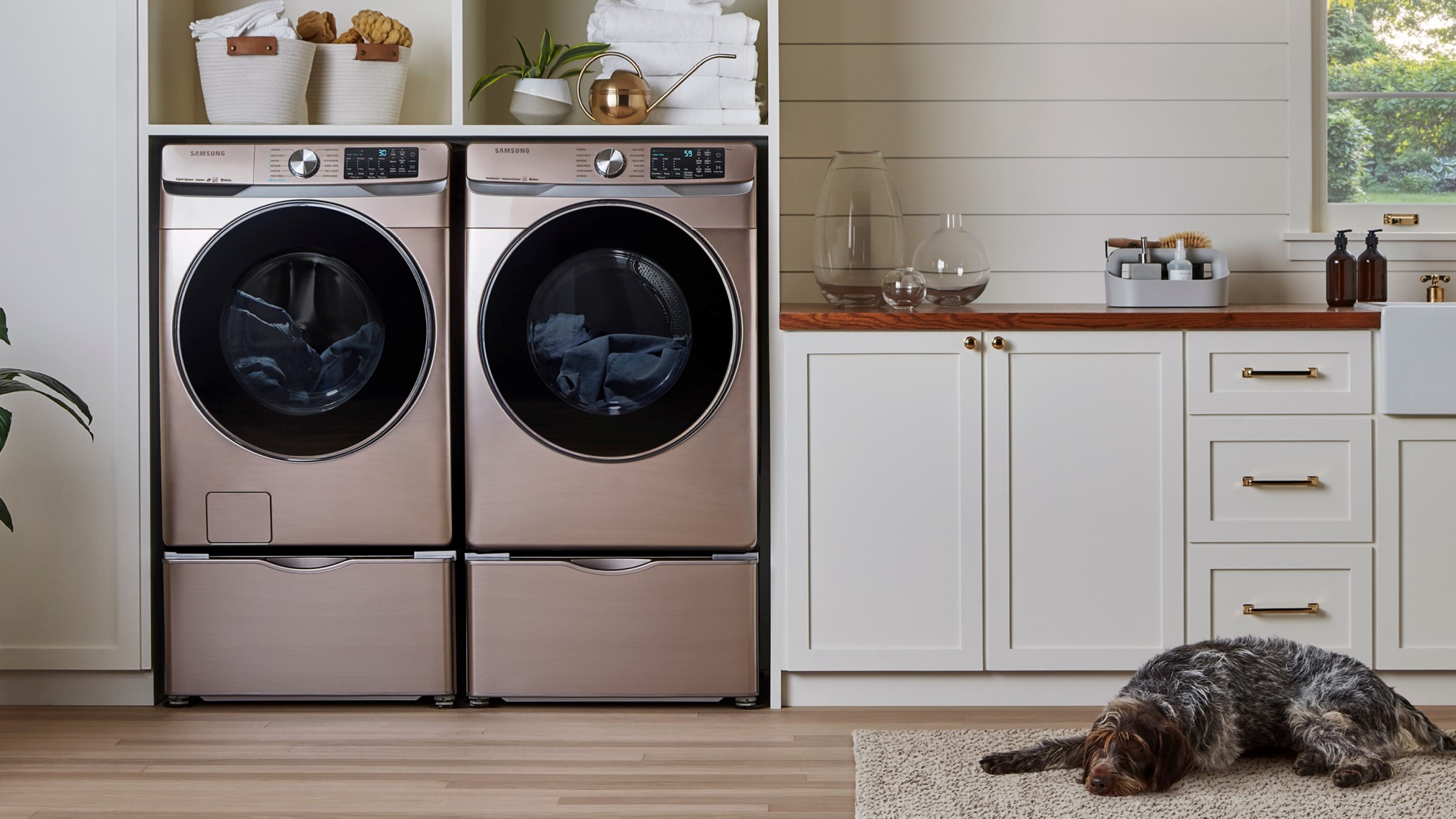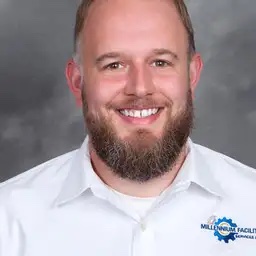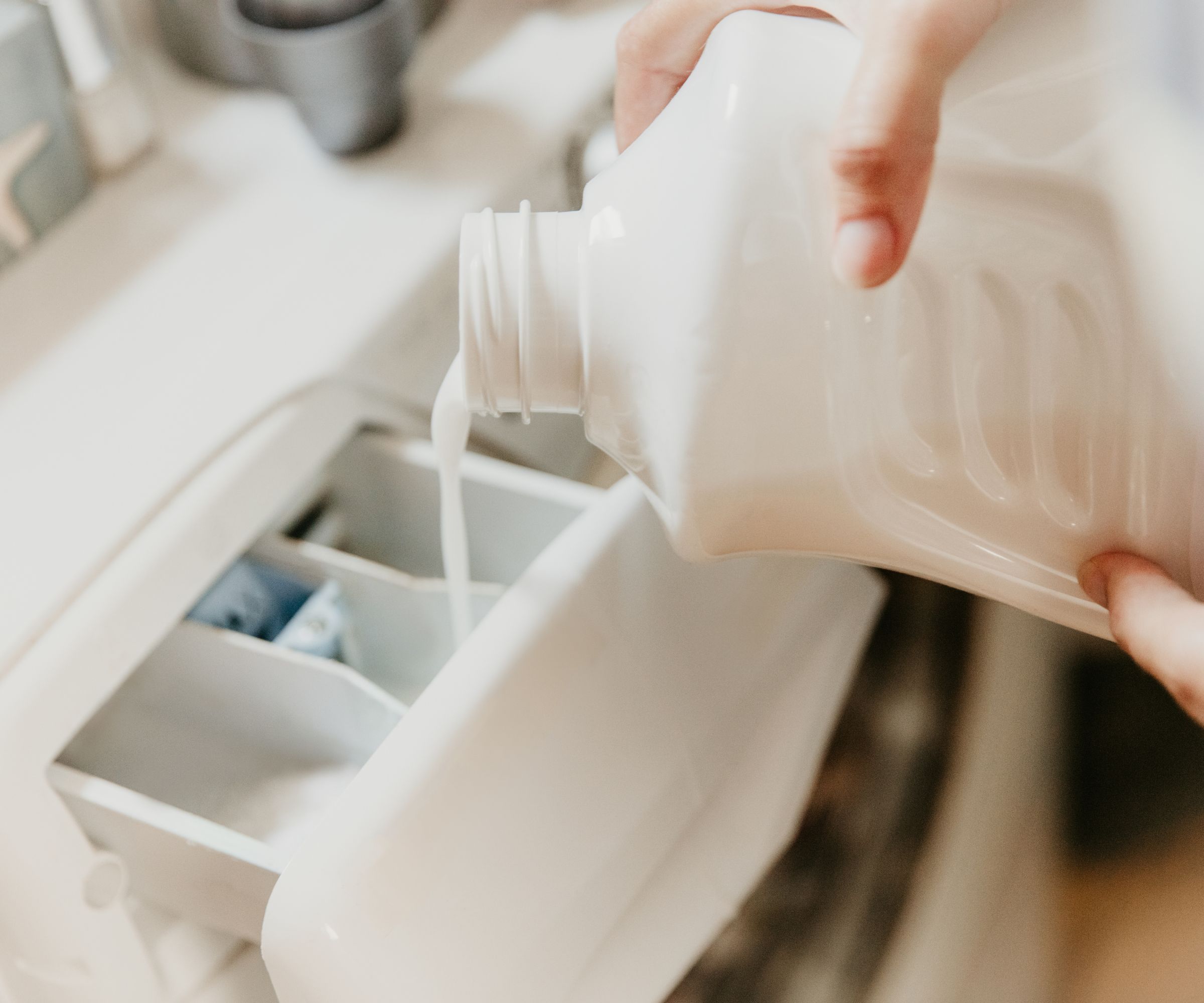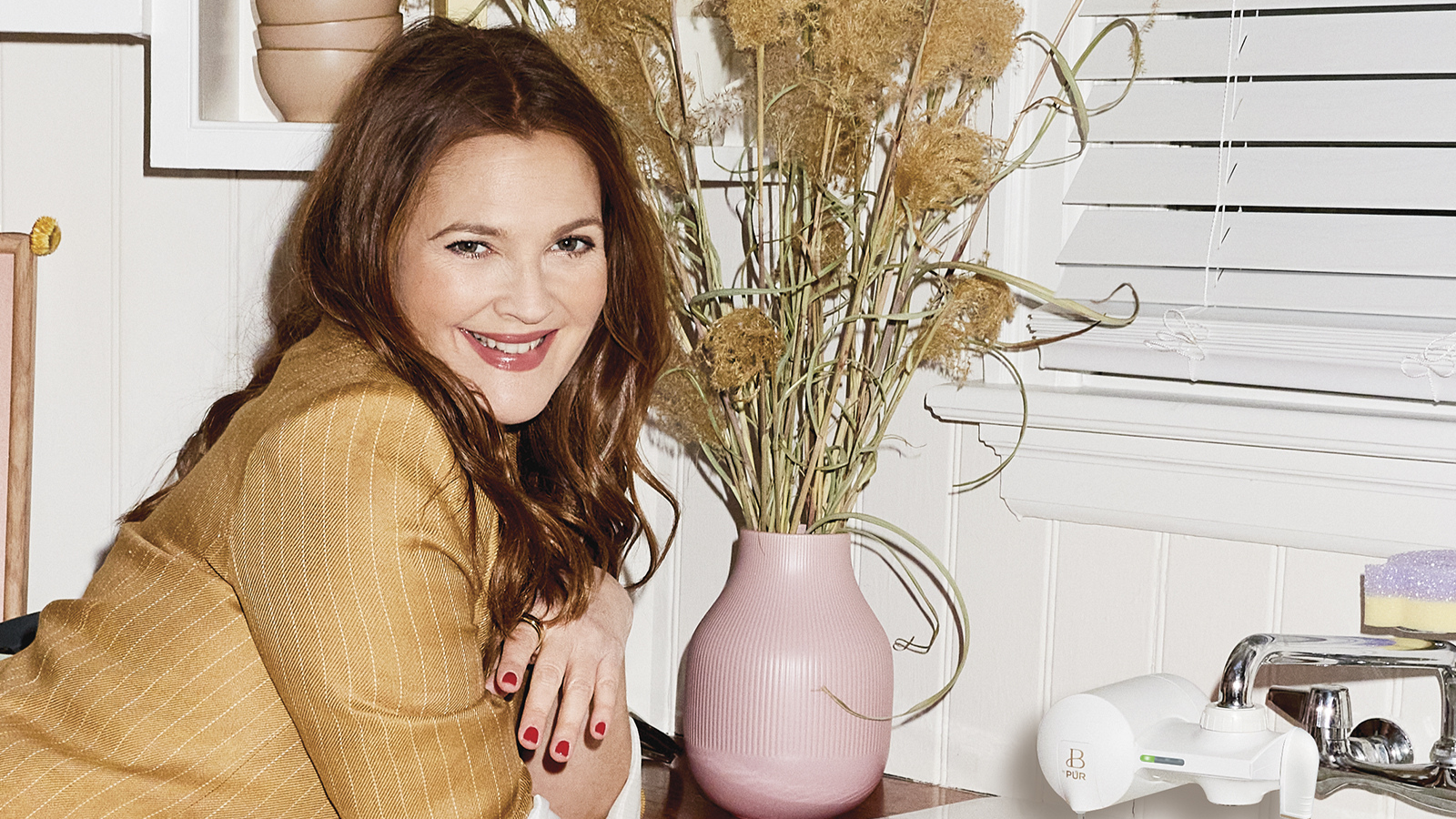How to sanitize and disinfect a washer and dryer – options for cleaning the drums, doors and more
Keeping your washer and dryer hygienic and clean is as important as cleaning the rest of your space – so don’t neglect this job

Our washing machines and clothes dryers go through a lot as they cleanse and prepare our laundry for us – which means that sometimes, they, too, need a little TLC to help them perform at their best, ensuring they last for the long haul.
In fact, for many of us, our washers and dryers work hard every day of the week (and sometimes multiple times a day if you have little ones), and are often dealing with tough stains, old linens, dirty clothes and more. So it's little wonder that they, too, need to be sanitized and disinfected from time to time to ensure dirt, mold, mildew, and material residue aren’t building up within the appliance. We all want the machine that is cleaning our items to be clean itself!
How should you sanitize and disinfect your washing machines and clothes dryers to ensure both are fit to properly wash and dry your laundry in, then? Here, the experts reveal all...
How to sanitize and disinfect a washer and dryer
Washers and dryers have various components, all of which you need to address to completely sanitize the grubby, grimy, and unhygienic parts of the machine.
However, the section that is likely to be the most in need of a disinfectant is the main drum itself, which is why it's a wise place to begin with both your washer and dryer.

1. Utilize white vinegar and baking soda for your washer
White vinegar and baking soda can both be invaluable tools when it comes to sanitizing your washer (which by nature experiences damp conditions), as they are effective at addressing things like mold and mildew. But, to properly disinfect your washing machine, it needs to be combined with the high heat of this appliance.
'Turn on your washer to the hottest setting and longest cycle,' cleaning professional Vanessa Terra Bossart, owner at Green Terra Cleaning says. 'Pour 4 cups of white vinegar, and add 1 cup of baking soda to the drum. Then, start the cycle with just these cleaning agents inside; this helps clean the drum and hoses and removes grime and odors.'
Appliance expert Austin Jones, CEO of Millennium Facility Services agrees, explaining why this method is so effective. 'The high heat will kill bacteria, and the acid in vinegar cuts through built-up grime. These chemicals will kill bacteria and break down mold and mildew throughout the machine.'
If you don't have time for this method however, don't feel compelled to entire empty cycle (though it is very effective). 'If you don’t want to run a cycle, use a cloth soaked in a mixture of water and white vinegar to wipe down inside the drum. Leave the lid open to air dry completely,' Vanessa suggests.
Your washing machine may even have a recommended setting for sanitizing itself, where the addition of vinegar and baking soda can also come in handy. 'Many modern washers have a self-clean cycle,’ cleaning expert Adam Moore, owner and operator of Paradise Home Cleaning, points out.
'Follow your manufacturer's instructions to run this cycle using hot water and a washing machine cleaner or, as mentioned, a mixture of vinegar and baking soda. This helps remove mold, mildew, and detergent buildup,' he concludes.

Adam Moore is a cleaning expert, and is the owner and operator of Paradise Home Cleaning, a residential & commercial house cleaning company based in Southern Ontario.
2. Use hydrogen peroxide for your dryer
Though white vinegar, baking soda and and a hot wash cycle is useful for sanitizing a washing machine, you'll need to take a slightly different approach for a clothes dryer, given that it can’t run with any water on it.
Instead, a dryer will need to be disinfected using a more manual approach. To do this, Austin advises picking up a different kind of disinfectant. 'For the dryer, wipe down the entire interior with a disinfectant like diluted bleach or hydrogen peroxide,' he suggests. ‘Pay extra attention to the seal and door rim, where mildew and germs accumulate.'
He does however suggest that running a dryer cycle can be useful, too, to finish off this process. 'Let the hydrogen peroxide or diluted bleach sit, then run an air fluff cycle to remove any remaining moisture before drying clothes,' Austin says.

Austin Jones is an appliance expert and CEO of Millennium Facility Services, which has been one of the Southeast’s leading facilities maintenance providers since 1990. Austin himself has over 30 years in the industry.
3. Sanitize the detergent drawer of your washer

Our detergent drawers are so often neglected, and can be especially prone to a build-up of leftover product – so it's important to include them in the sanitization of your machine, too!
To disinfect it, all you really need to do is remove the drawer and give it a good old scrub with some hot water. Adam suggests, 'remove the detergent drawer (if possible) and clean it thoroughly with warm water and a mild detergent, such as dish soap or your favorite all-purpose cleaner. Try using an old toothbrush to scrub any residue away.'
Once this is done, give the drawer a thorough rinse and dry and replace it, ready for your next wash load.
4. Clean the door of both appliances
The doors (and seals around the doors) of our washers and dryers can present the biggest problems when it comes to creating a sanitary appliance for us to use, simply because this is where extra water, dirt and fluff tend to get lodged after a washing or drying session.
Prolonged exposure to water and moisture here can also lead to mold and mildew build-up; so your washer or dryer won’t be completely disinfected until you have addressed this spot.
'The rubber gasket around the door of your washer or dryer often collects moisture and debris,' Vanessa says. 'To sanitize it, wipe it thoroughly with a cloth soaked in a mixture of equal parts water and white vinegar, and this will effectively remove any visible mold or grime.'
Vanessa also advises airing the door out too, as much as is possible. 'After each wash, leave the washer or dryer door or lid open to allow air circulation, which helps prevent mold and mildew growth.'
5. Clean the filters and vents of both appliances

Finally, the filters and vents within our washing machines and clothes dryers can easily become a hub for certain nasties, trapping in all of the fluff and bacteria that has come off of our dirty towels, underwear, clothes, towels and sheets.
As such, the final part of the sanitization process for these appliances is to empty these out and clean them. In fact, not doing so means you risk a build-up of this debris that could even be hazardous, with overly full lint traps in dryers liable to causing fires.
When it comes to your washing machine, Vanessa explains, 'some washers have a lint trap or filter that needs periodic cleaning. Refer to your manual to locate and clean this filter to prevent clogs and odors; you can usually take this trap out and wash it in warm soapy water to actually disinfect it.'
Dryers too have lint traps which require a thorough sanitization. To do this, Adam advises, 'remove the lint trap and clean it thoroughly after each use. Use a vacuum hose or lint brush to remove lint from the trap housing.
'And occasionally, use a vacuum attachment to clean out the lint screen housing to prevent build-up and improve airflow,' he continues.
FAQs
What to keep in mind about sanitizing your washer and dryer
Sanitizing your washer and dryer is pretty straightforward, but it’s worth remembering that these are important appliances that need to be properly cared for to ensure they continue to work well.
As such, as well as following the above suggestions, the experts advise being cautious about the products you use to sanitize your washer and/or dryer. Adam says, 'it’s essential to use appropriate cleaners. While natural alternatives like vinegar are usually very safe, if you want to use a store-bought product, follow manufacturer recommendations for cleaning products to avoid damaging your appliances,' he explains.
Regular maintenance is also imperative for ensuring your washer or dryer is kept hygienic at all times. 'Set a schedule for deep cleaning and maintenance tasks to keep your washer and dryer in good condition,' Adam suggests.
It’s also important to ensure you’re doing what you can to minimize dirt and grime from forming on your washer or dryer in the first place. For example, removing wet clothes from your dryer immediately will help prevent mold and mildew from appearing, and airing out your washer and dryer on a regular basis will also prevent any lingering odors or mustiness.
Sign up to the Homes & Gardens newsletter
Design expertise in your inbox – from inspiring decorating ideas and beautiful celebrity homes to practical gardening advice and shopping round-ups.
Amy Hunt is a freelance lifestyle writer and editor primarily covering homes and interiors, wellness, travel and careers. She was previously Lifestyle Editor at woman&home, commissioning and editing the homes, books and features sections of the website,
In 2019, she won the AOP Digital Journalist of the Year Award, for her work on womanandhome.com. Having worked in the industry for over eight years, she has contributed to a range of publications including Ideal Home, Livingetc, T3,Goodto, Woman, Woman’s Own, and Red magazine.
-
 7 of the best tomatoes for growing in pots - expert growers pick their top varieties ideal for large harvests from containers
7 of the best tomatoes for growing in pots - expert growers pick their top varieties ideal for large harvests from containersYou can enjoy bumper homegrown harvests in small spaces
By Drew Swainston Published
-
 Drew Barrymore creates a 'balanced' kitchen in 4 easy steps – her rules will make your small, compact countertops feel beautiful
Drew Barrymore creates a 'balanced' kitchen in 4 easy steps – her rules will make your small, compact countertops feel beautifulDrew proves that with the right styling (and chic appliances), you can make even the smallest of kitchens look harmonious
By Hannah Ziegler Published
-
 How to clean a patio – 6 different methods, and when you must use a chemical cleaning agent
How to clean a patio – 6 different methods, and when you must use a chemical cleaning agentFrom manual scrubbing, natural solutions or calling in the pros, industry experts reveal the benefits and considerations of each method
By Andy van Terheyden Published
-
 5 surprising but brilliant ways to clean with old socks – from perfectly buffing stainless steel to deterring pests naturally and more
5 surprising but brilliant ways to clean with old socks – from perfectly buffing stainless steel to deterring pests naturally and moreTackle dust in tricky corners, clean your mirrors and even banish bad odors with those rogue single socks
By Andy van Terheyden Published
-
 5 things people with clean upholstery always do – simple, quick and oh-so-effective
5 things people with clean upholstery always do – simple, quick and oh-so-effectiveEnsure your furnishing looks clean year-round with these expert tips
By Seraphina Di Mizzurati Published
-
 'Wick away the ick' – 6 things people with clean laundry rooms always do to make this hardworking space shine
'Wick away the ick' – 6 things people with clean laundry rooms always do to make this hardworking space shineThese tips on how to clean your laundry room will banish grime
By Seraphina Di Mizzurati Published
-
 How safe are carpet deodorizers? As a seasoned vacuum tester, I urge you to try alternative methods
How safe are carpet deodorizers? As a seasoned vacuum tester, I urge you to try alternative methodsNatural cleaning is always the answer
By Dan Fauzi Published
-
 'The world will not end' – 5 cleaning habits to quit for a happier, easier life, and what to do instead
'The world will not end' – 5 cleaning habits to quit for a happier, easier life, and what to do insteadGet your home sparkling, minus the stress
By Ciéra Cree Published
-
 9 things you can clean with glycerin – this cheap and natural cleaner is perfect for indoor and outdoor use
9 things you can clean with glycerin – this cheap and natural cleaner is perfect for indoor and outdoor useFrom patio furniture to silverware, this hydrating and gentle cleaning agent will work miracles
By Ciéra Cree Published
-
 How to clean a terrazzo floor in 5 steps – expert tips to scrub, shine, and seal this sparkling floor finish
How to clean a terrazzo floor in 5 steps – expert tips to scrub, shine, and seal this sparkling floor finishAvoid damage and protect it's shine with these expert tricks
By Chiana Dickson Published


